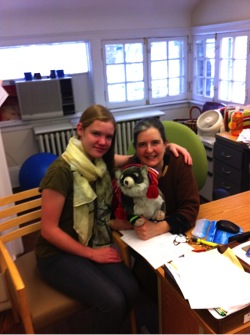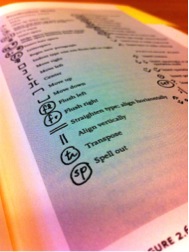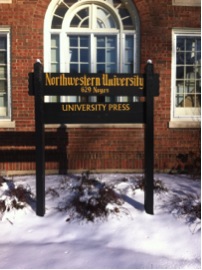Northwestern University Press, Reed Winter Externship Program, Julia Green

Julia Green, sophomore history major, was a Reed winter externship program participant. The following blog is a reflection of her experience working at the Northwestern University Press with Anne Gendler (class of ’81)
A Quick Look at Northwestern University Press:
108,000 pieces of paper used per year (rough estimate, not including printed books)
1893 NUP was established
60 books published per year
9 months to publish a book
1 stuffed animal raccoon in the office, named Bentley
For two weeks over winter break, I worked alongside Anne Gendler, Reed alumna of ’81, at Northwestern University Press, where she is the Managing Editor and Manager of Design and Production. After spending 10 nine-to-five days there, I developed a thorough understanding of what it is like to work at a small university press. I chose this externship in particular because it was located in Evanston (where I’m from), and it offered an opportunity to learn about a process that I was curious about.

As a history major, I do quite a bit of reading and writing. I’ve also spent some time doing peer editing. Although I had never considered a career in publishing prior to discovering this externship, I figured it might be something I was well equipped to do. My externship at NUP was a chance to explore something new and develop a connection to a Reed alum.
The Press, like many institutions at Northwestern, is housed, quite literally, in a beautiful old house. It is nestled in a residential neighborhood, conveniently located just a block away from where I live. My total commute time was about two minutes! The atmosphere at NUP was cozy and inviting. The building itself felt very homey; the floorboards creaked, the aroma of coffee filled the air, and the heat was always turned up a little too high.
All of the staff were very friendly and down-to-earth. Shadowing and doing tasks for Anne, my externship host, felt a lot like collaborating with a good friend. She immediately gave me a project to work on: checking two manuscripts for typesetting errors, such as the positioning of page numbers (folios) and consistency between the Contents page and chapter pages, as per Chicago Manual of Style (“the bible”). This assignment required that I flip through two tall stacks of paper and take a close look at every page, multiple times, in order to check for possible errors. In the following two weeks, I did this for about five other manuscripts. It felt tedious at times, but spotting that misplaced running head or incorrectly justified paragraph was like finding a carefully concealed Easter egg—it is surprisingly satisfying.
In addition to checking “pass three” (final stage) manuscripts, I also got to observe and take part in many other steps of the editing process: I looked at “pre-transmittal” manuscripts, which are the first documents the Press receives after the author’s work has been accepted by the Acquisitions team; I watched Anne “style-tag” a digital manuscript, which involves coding each line so that it is formatted correctly when the book is typeset; and I “accepted” changes that an author made after the first round of editing, called copyediting
I also spent a considerable amount of time with one particular manuscript, which had been typeset but not yet proofread and still needed quite a bit of work. Because it was an edited volume, the writing quality varied from chapter to chapter, and some authors were more receptive to changes than others. Dialogue between editor and author ensures that both parties are satisfied with the end result, but it can also slow down the publishing process. As I observed Anne correspond via email with the authors, I learned that one of the most critical skills in editing, besides noticing the changes that need to be made, is to communicate these “suggestions” diplomatically.
to changes than others. Dialogue between editor and author ensures that both parties are satisfied with the end result, but it can also slow down the publishing process. As I observed Anne correspond via email with the authors, I learned that one of the most critical skills in editing, besides noticing the changes that need to be made, is to communicate these “suggestions” diplomatically.

I also attended meetings among members of the Editorial, Design, and Production staff, as well as an all-staff meeting, in which the Acquisitions; Editorial, Design, and Production; and Sales and Marketing departments met. These meetings made me realize just how much coordination is required, since there are a few books at each stage in the publishing process at any given moment.
There were two things about the externship that I absolutely loved. One was spotting typos, grammatical errors, and issues with content that were changed as a result of my efforts. Seeing authors write “OK” to my changes and watching the manuscripts edited to reflect my corrections was very fulfilling. I look forward to holding a copy of one of those books in my hands and knowing that I shaped the final product. The second aspect of the externship that I loved was getting to know Anne. I realized that we are similar in many ways—quiet, thoughtful, conscientious, and critical thinkers. It’s amazing to work alongside someone who graduated from Reed over three decades ago, and connect over the fact that, at heart, you’re both Reedies. It was inspiring to see that after all these years, Anne still incorporates many of the things she learned at Reed into the way she approaches her work—I respected her a lot for that. I hope that down the line, I too will use the lessons Reed has taught me every day, regardless of what my job is.
Tags: reed winter externship , publishing, editing, literature
